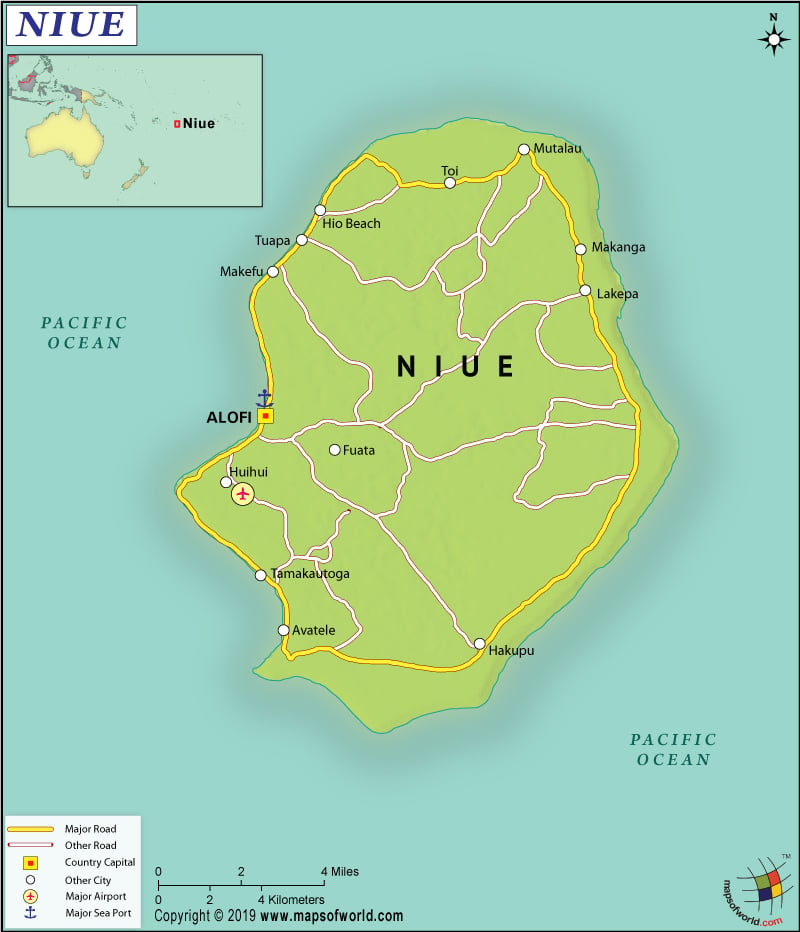What are the Key Facts of Niue?

|
Official Name |
Niue |
|
Continent |
Oceania |
|
Capital |
Alofi |
|
Largest City |
Alofi |
|
Coordinates |
-19.053327, -169.859525 |
| Area |
100.95 sq mi ( 261.46 sq km) |
|
Land Boundaries |
0 mi ( 0 km) |
|
Coastline |
40 mi ( 64 km) |
|
Currency |
Niue dollar, New Zealand dollar (NZ$) (NZD) |
|
Neighboring Countries |
Tonga, Samoa, Cook Islands |
|
Population |
1,624 (2016 est. ) |
|
Official Languages |
English, Niuean |
|
Major Religion |
Christianity |
|
National Day |
19 October (Independence Day) |
|
National Anthem |
“Ko e Iki he Lagi” |
|
Form of Government |
Unitary parliamentary constitutional monarchy |
|
Monarch |
Elizabeth II |
|
Governor-General |
Dame Patricia Reddy |
|
GDP per capita (PPP) |
NA |
|
GDP per capita (nominal) |
NA |
|
HDI |
NA |
|
Literacy Rate (%) |
NA |
|
Space Agency |
NA |
|
Military Expenditure Ranking |
NA (SIPRI, 2017) |
|
No. of Olympic Medals |
NA |
|
Driving Side |
left |
|
Calling Code |
+683 |
|
Time Zone |
UTC-11 |
|
Internet TLD |
.nu |
Where is Niue?
Niue is located in Oceania. It is an island that is situated to the east of Tonga in the South Pacific Ocean.
What is the Geography of Niue?
Niue is spread across a total area of 260 sq km (100 sq mi), out of which 260 sq km (100 sq mi) is land area and 0 sq km (0 sq mi) is water area. It has no land boundary. However, this Oceanic country has a 64 km (40 mi) long coastline. The country is one of the largest coral atolls in the world. It is located around 1,500 m (2,414 mi) northeast of New Zealand.
The western coast of Niue has two large bays. While Avatele Bay is located in the south, Alofi Bay is situated in the center of the island. The area close to the coast has many limestone caves. The island is almost entirely surrounded by a coral reef. On the western side of the island (near Alofi, to be particular), a major break can be found. The terrain is characterized by steep limestone cliffs along the coastal area as well as the central plateau.
The highest elevation point of Niue is an unnamed one that is 80 m (263 ft) high. It is located around 1.4 km (0.9 mi) to the east of Hikutavake. The Pacific Ocean is the lowest elevation point of the country at 0 m (0 ft). There are no significant mountains or rivers in this Oceanic country.
Niue Island in the Pacific Ocean has a tropical climate. It is situated in the Southern Hemisphere because it is located in the northern parts of the Tropic of Capricorn. During November-to-April, the weather remains hot and muggy. During the daytime, the temperature revolves around 28/29 °C (82/84 °F). However, at nighttime, the average temperature remains around 22/24 °C (72/75 °F). Sometimes, the temperature can also exceed 35 °C (95 °F).
It is also the rainy period of the year. During May-to-October, the weather remains cooler and drier. The south-east trade winds also blow during this time. During the daytime, the temperature revolves around 25/26 °C (77/79 °F). However, at nighttime, the average temperature remains around 20/21 °C (68/70 °F). The temperature can also go down below 15 °C (59 °F), especially during nighttime in July and August.
This Oceanic country gets an average rainfall of 2,000 mm (79 in) annually. Maximum rainfall takes place during January-March. During this time, the amount of precipitation can reach 250-300 mm (10-12 in) per month. Even in the drier months (June-September), per month precipitation can be around 80-100 mm (3-4 in). The sea temperature remains warm round the year. It only dips below 25 °C (77 °F) during July-to-October.
What is the Economy of Niue?
The economy of Niue is one of the smallest in the world. It suffers from the typical problems from which other Pacific countries suffer from. Some of those problems are geographical isolation, a very small population, and the availability of a limited amount of resources. Data shows that the nominal GDP of Niue was US$24.938 million in 2016.
The economy is mainly dependent upon the agricultural sector and small industries. Subsistence gardening is the main agricultural produce. The small scale industries too dependent upon processing of coconut cream, lime oil, passion fruit, and honey. For export purposes, some cash crops are also grown. One of the main revenue earners of Niue is the postage stamps sale to foreign collectors.
In recent times, the government is trying to boost its GDP through tourism promotion and the provision of special sops to the financial services. However, the economy is heavily dependent upon foreign aid, especially from New Zealand. The fiscal deficit is a regular phenomenon in Niue and the public employees are paid wages on the basis of grants received from New Zealand. The main import items are fuels, manufactures items, live stocks, food, drugs, chemicals, lubricants, and machinery.
What is the Transportation System of Niue?
The transportation system is Niue is highly restricted. There is just 234 km (145 mi) of roadways, out of which 210 km (130 mi) is paved and the rest 24 km (15 mi) is unpaved. Only one airport (Niue International Airport) is present in the country. The only airline serving the country is Air New Zealand. The country also has a seaport at Alofi.
What International Organizations is Niue part of?
WHO, UNESCO, ACP, AOSIS, FAO, IFAD, OPCW, PIF, Sparteca, SPC, UPU, WIPO, WMO
Related Map
https://www.mapsofworld.com/niue/location-map.html
